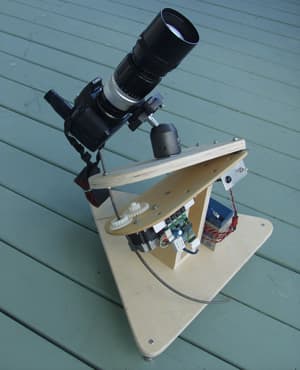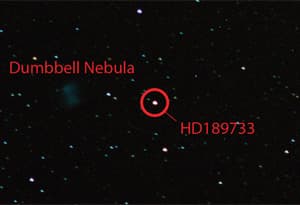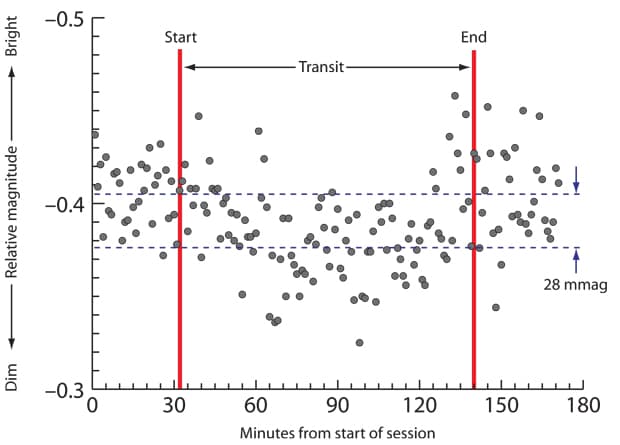David Schneider Detects An Exoplanet Using A DSLR Camera
David Schneider has succeeded in detecting a known exoplanet using a digital single-lens reflex (DSLR) camera. Yep! You read it right! In the experiment, he used Canon EOS Rebel XS DSLR and a 300-millimeter Nikon telephoto lens. The basic problem he faced was that the rotation of the Earth causes stars to continuously shift position in the sky. For the detection of the subtle signs of the existence of an orbiting exoplanet compensation was required for this shift. To do that, he built his own hinged “barn door†tracker using two pieces of plywood hinged together. He drived the tracker using small gears connected to stepper motor controlled via driver board using Arduino microprocessor which allowed setting the rate at which the doors separate. Then he mounted the camera on a self-made sturdy wooden platform. The final component of the tracker- Amazon.com bolted to the top, which allowed orientation of the camera in any direction.

After building the tracker, the next step was to point the camera at the target star. After doing some homework, he pointed it at HD 189733 and took photos using software that came with Canon camera. It allowed him to adjust the camera settings, take shots, record images directly to computer, and program a sequence of timed exposures. He also purchased an #-Link-Snipped-# so that the camera ran for hours without its battery giving out. Using a low ISO setting, he took sequences of images of HD 189733 for a few nights, settling on a routine of taking one 50-second exposure per minute.

The hardest part of the whole experiment proved to be waiting for an opportunity to observe the transit of HD 189733’s exoplanet, which takes place once every 2.2 days meaning that transits would occur during daytime or were too close to the horizon are impossible to observe. Finally an opportunity came in mid-October. He recorded images for almost 3 hours, beginning about a half-hour before the start of the 108-minute transit and captured the transition from normal brightness to ever-so-slightly dimmed and back to normal again.
Keeping in mind various influences such as changes in the transparency of the atmosphere, and the response of a camera’s imaging sensor being seldom uniform (if the position of the target shifts in the field of view, the amount of light registered will also change, even if there is no actual change in brightness). To compensate this, he used free software called #-Link-Snipped-#, which allowed performing the corrections needed to calculate the brightness of HD 189733, as well other four reference stars.

After loading the results from Iris to Excel (to make differential-photometry calculations), he compared HD 189733 with one of the four reference stars to compensate for changes in atmospheric conditions. The scatter in the final results was about the same size as the signal he was attempting to measure, but the general dip in brightness was easy enough to discern nevertheless. The average magnitude of the target star diminished and recovered just as the exoplanet’s transit began and ended. And the shift in magnitude was very close to, if not precisely, the 28-millimagnitude difference.
Source: #-Link-Snipped-#
After building the tracker, the next step was to point the camera at the target star. After doing some homework, he pointed it at HD 189733 and took photos using software that came with Canon camera. It allowed him to adjust the camera settings, take shots, record images directly to computer, and program a sequence of timed exposures. He also purchased an #-Link-Snipped-# so that the camera ran for hours without its battery giving out. Using a low ISO setting, he took sequences of images of HD 189733 for a few nights, settling on a routine of taking one 50-second exposure per minute.

The hardest part of the whole experiment proved to be waiting for an opportunity to observe the transit of HD 189733’s exoplanet, which takes place once every 2.2 days meaning that transits would occur during daytime or were too close to the horizon are impossible to observe. Finally an opportunity came in mid-October. He recorded images for almost 3 hours, beginning about a half-hour before the start of the 108-minute transit and captured the transition from normal brightness to ever-so-slightly dimmed and back to normal again.
Keeping in mind various influences such as changes in the transparency of the atmosphere, and the response of a camera’s imaging sensor being seldom uniform (if the position of the target shifts in the field of view, the amount of light registered will also change, even if there is no actual change in brightness). To compensate this, he used free software called #-Link-Snipped-#, which allowed performing the corrections needed to calculate the brightness of HD 189733, as well other four reference stars.

After loading the results from Iris to Excel (to make differential-photometry calculations), he compared HD 189733 with one of the four reference stars to compensate for changes in atmospheric conditions. The scatter in the final results was about the same size as the signal he was attempting to measure, but the general dip in brightness was easy enough to discern nevertheless. The average magnitude of the target star diminished and recovered just as the exoplanet’s transit began and ended. And the shift in magnitude was very close to, if not precisely, the 28-millimagnitude difference.
Source: #-Link-Snipped-#
Replies
You are reading an archived discussion.
Related Posts
Amar Ramesh Photography was started in the year 2010. Amar is an Electronics and Communications engineer by degree. He also completed Master of Science in Electrical and Electronics engineering from...
Is there any CEan who knows QT development ? I want to develop a QT based app for RPi which includes nothing but joystick like interface with Right-Left-Bottom-Top button and...
The stuffing inside a samosa probably will feel the same.
https://l3.yimg.com/bt/api/res/1.2/u...erun/vox.com/365d40cabc1c9dc40a97ca3f530b0285
(Posted by Fredski in CR4 forum)
After launching Yoga Tablet 2 Pro last week, the China-based company has now launched its high-end tablet, ThinkPad 8 at Rs. 39,999. This is Lenovo’s first Windows 8 tablet from...
This may be of interest to some:
https://insights.globalspec.com/arti...rk=cr4digest&et_rid=419257195&et_mid=71448237
